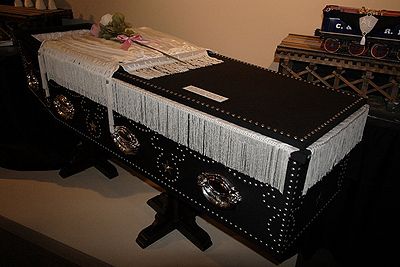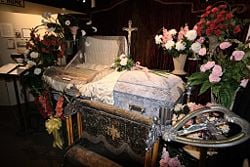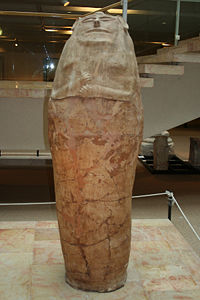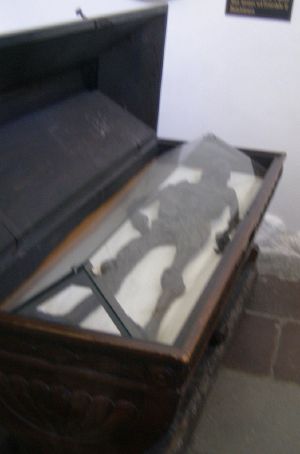Difference between revisions of "Coffin" - New World Encyclopedia
m |
(started) |
||
| Line 1: | Line 1: | ||
| − | {{Claimed}} | + | {{Claimed}}{{Started}} |
[[Category:Politics and social sciences]] | [[Category:Politics and social sciences]] | ||
[[Category:Anthropology]] | [[Category:Anthropology]] | ||
Revision as of 16:18, 5 September 2007

A coffin (in North American English, also known as a casket) is a funerary box used in the display and containment of deceased remains — either for burial or cremation.
Some people at Coffin Talk say a casket is a casket and a coffin is a coffin.
The word comes ultimately from Greek kophinos, a basket. In English, the word wasn't used in a funeral sense until the 1500s.[citation needed]
Practices
Any box used to bury the dead in is a coffin. Use of the word "casket" in this sense began as a euphemism introduced by the undertaker's trade in North America; a "casket" was originally a box for jewellery.[1] Some Americans[attribution needed] draw a distinction between "coffins" and "caskets"; for these people, a coffin is a tapered hexagonal or octagonal (also considered to be anthropodial in shape) box used for a burial. A rectangular burial box with a split lid used for viewing the deceased is called a "casket" as seen in the picture above.
Receptacles for cremated human ashes (sometimes called cremains) are called urns.
A coffin may be buried in the ground directly, placed in a burial vault or cremated. The above ground burial is in a mausoleum. Often it is a large cement building at a cemetery, housing hundreds of bodies, or a small personal crypt.
Some countries practice one form almost exclusively;[citation needed] in others, it depends on the individual cemetery. The handles and other ornaments (such as doves, stipple crosses, crucifix, masonic symbols etc.) that go on the outside of a coffin are called fittings (sometimes called 'coffin furniture', not to be confused with furniture that is coffin shaped) while organising the inside of the coffin with drapery of some kind is known as "trimming the coffin."
Cultures that practice burial have widely different styles of coffin. In some varieties of orthodox Judaism, the coffin must be plain, made of wood, and contain no metal parts nor adornments. These coffins use wooden pegs instead of nails. In China and Japan, coffins made from the scented, decay-resistant wood of cypress, sugi, thuja and incense-cedar are in high demand.[citation needed] In Africa, elaborate coffins are built in the shapes of various mundane objects, like automobiles or aeroplanes.[citation needed]
Sometimes coffins are constructed to display the dead body, as in the case of the glass-covered coffin of Haraldskær Woman on display in the Church of Saint Nicolai in Vejle, Denmark.
When a coffin or casket is used to transport a deceased person, it can also be called a pall, a term that also refers to the cloth used to cover the coffin.
Modern coffins
Today manufacturers offer features that they[attribution needed] claim will protect the body. For example, some may offer a protective casket that uses a gasket to seal the casket shut after the coffin is closed for the final time. Many manufacturers offer a warranty on the structural integrity of the coffin. However, no coffin will preserve the body, regardless of whether it is a wooden or metal coffin, a sealed casket, or if the deceased was embalmed beforehand. In some cases, a sealed coffin may actually speed up rather than slow down the process of decomposition. An airtight coffin, for example, fosters decomposition by anaerobic bacteria, which results in a putrefied liquification of the body, and all putrefied tissue remains inside the container, only to be exposed in the event of an exhumation. A container that allows air molecules to pass in and out, such as a simple wooden box, allows for aerobic decomposition that results in much less noxious odor and clean skeletonization.
Coffins are made of many materials, including steel, various types of wood, and other materials such as fiberglass. There is now emerging interest in eco-friendly coffins made of purely natural materials such as bamboo.[2]
Coffins are sometimes personalized to offer college insignia or different head panels to better reflect the deceased's life choices.
Cremation coffins
With the resurgence of cremation in the Western world, manufacturers have begun providing options for those who choose cremation. For a direct cremation a cardboard box is normally used. Those who wish to have a funeral visitation (sometimes called a viewing) or traditional funeral service will use a coffin of some sort.
Some choose to use a coffin made of wood or other materials like particle board. Others will rent a regular casket for the duration of the services. These caskets have a removable bed and liner which is replaced after each use. There are also rental caskets with an outer shell that looks like a traditional coffin and a cardboard box that fits inside the shell. At the end of the services the inner box is removed and the deceased is cremated inside this box.
Casket industry
In the United States, a number of companies produce caskets. Some manufacturers do not sell directly to the public, and only work with licensed funeral homes. In that case, the funeral home usually sells the casket to a family for a deceased person as part of the funeral services offered, and in that case the price of the casket is included in the total bill for services rendered.
Often funeral homes will have a small showroom to present families with the available caskets that could be used for a deceased family member. In many modern funeral homes the showroom will consist of sample pieces that show the end pieces of each type of coffin that can be used. They also include samples of the lining and other materials. This allows funeral homes to showcase a larger number of coffin styles without the need for a larger showroom. Examples of such showrooms can be seen on the A&E show Family Plots, and the HBO drama Six Feet Under.
One manufacturer of caskets is the New Melleray Abbey of rural Peosta, Iowa. The monks of this abbey build wooden caskets and urns for their own use, as well as for sale to the general public. The caskets are popularly known as Trappist Caskets.
Under U.S. federal law, if a family provides a casket they purchased elsewhere, the establishment is required to accept the casket and use it in the services. If the casket is delivered direct to the funeral home from the manufacturer or store, they are required to accept delivery of the casket. The funeral home may not add any extra charges or fees to the overall bill if a family decides to purchase a casket elsewhere.
Unusual coffins
Custom coffins are occasionally created and some companies also make set ranges with non-traditional designs. These include painting of peaceful tropical scenes, sea-shells, sunsets and cherubs. Some manufacturers have designed them to look like gym carry bags, guitar cases and even yellow dumpster bins. Others coffins are left deliberately blank so that friends and family can inscribe final wishes and thoughts upon it to the deceased. The rock band Kiss has made a coffin called the Kiss Kasket for their most diehard fans; Dimebag Darrell, guitarist of both Pantera and Damageplan, was buried in one.
In Taiwan, coffins made of crushed oyster shells were used in the 18th and 19th centuries.
Notes
- ↑ casket, coffin (nn.) from the Columbia Guide to Standard American English via Bartleby.com
- ↑ Bamboo Coffins "Coffin-maker resurrects tradition", from BBC Business News, published 2001-12-28
ReferencesISBN links support NWE through referral fees
Credits
New World Encyclopedia writers and editors rewrote and completed the Wikipedia article in accordance with New World Encyclopedia standards. This article abides by terms of the Creative Commons CC-by-sa 3.0 License (CC-by-sa), which may be used and disseminated with proper attribution. Credit is due under the terms of this license that can reference both the New World Encyclopedia contributors and the selfless volunteer contributors of the Wikimedia Foundation. To cite this article click here for a list of acceptable citing formats.The history of earlier contributions by wikipedians is accessible to researchers here:
The history of this article since it was imported to New World Encyclopedia:
Note: Some restrictions may apply to use of individual images which are separately licensed.


